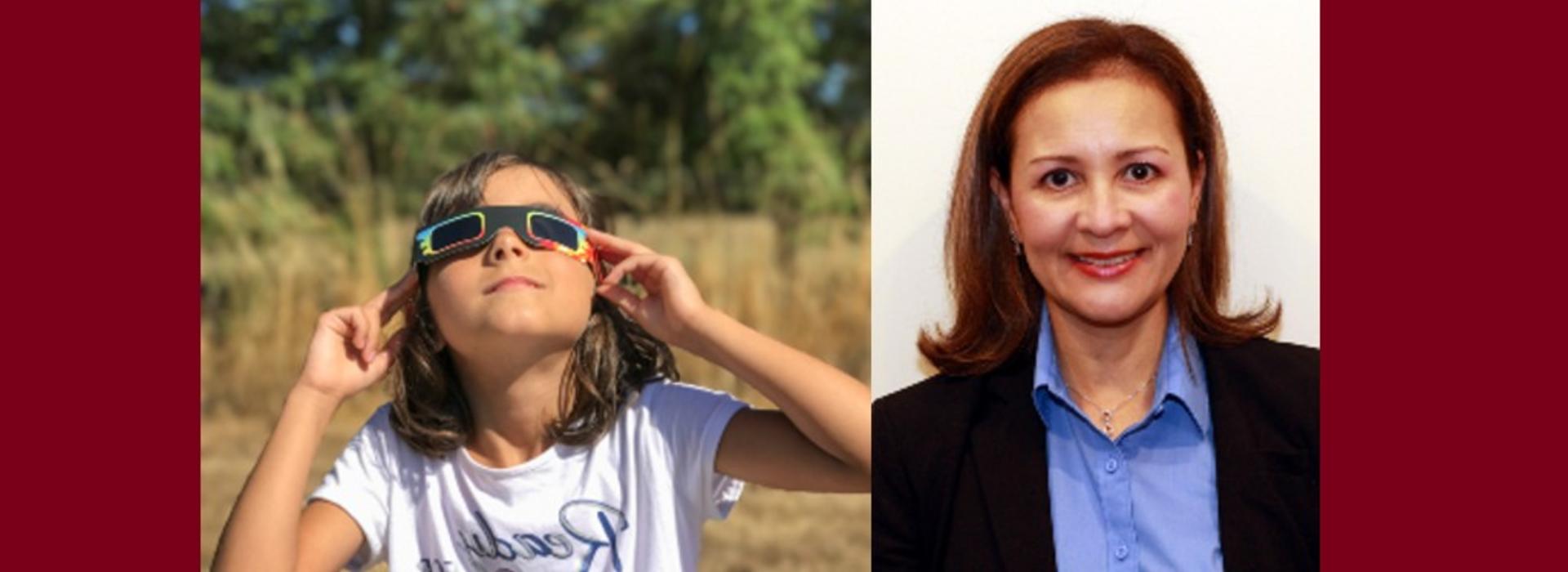
U of M Expert Alert: Solar eclipse and eye safety
MINNEAPOLIS/ST. PAUL (03/28/2024) — On April 8, parts of North America will experience a total solar eclipse. While this is an incredible sight, using protective eye equipment is critical.
Sandra Montezuma, MD, with the University of Minnesota Medical School and M Health Fairview, speaks about why looking directly at a solar eclipse is dangerous and how people can safely enjoy the event.
Sandra Montezuma, MD
“Staring directly into the sun or watching a solar eclipse can cause eye damage known as solar retinopathy or eclipse retinopathy. The retina is the nerve tissue layer that lies in the back part of the eye and is very sensitive to light. The injury is similar to thermal burns caused by a laser and harms the cells in the eye that help you see. Even a short duration of exposure — as little as a few seconds of fixation on the sun during the eclipse — can cause injury to the macula, which is located in the central part of the retina. This damage could result in temporary vision loss, blurred vision, distortion, or permanent vision loss.”
“During the eclipse, it is important to protect your eyes. When the moon blocks the sun’s bright face, it is not safe to look directly at the sun without specialized eye protection. Viewing the eclipse through binoculars, a camera lens, a telescope or regular sunglasses is not safe either. If you decide to watch this spectacular phenomenon, you need to wear eclipse safety glasses approved by the American Astronomical Society — carefully inspect your safety glasses and don’t use any that are scratched or damaged. Because Minnesota is outside the path of totality where only a partial solar eclipse will be visible, there is no safe time to look at the sun without eclipse glasses.”
“There is no proven treatment for solar retinopathy. The visual problems experienced after watching a solar eclipse can continue for several months. It could resolve without treatment, but in some cases, it can lead to permanent blurred vision and/or blind spots that interfere with activities like reading. The main management is prevention and education. Children are especially susceptible and must always be supervised during a solar eclipse.”
Contact
Sandra Montezuma, MD
Professor at the University of Minnesota Medical School
Email: mednews@umn.edu
Download a high resolution photo of Dr. Montezuma.
Dr. Sandra Montezuma is a professor at the University of Minnesota Medical School and retina specialist with M Health Fairview. Her research interests include stem cell research for age related macula degeneration, retina imaging, retinal implants, age-related macular degeneration, ocular trauma and inherited retinal dystrophies.
-30-
About “Expert Alert"
University of Minnesota experts can provide commentary, insights and opinions on various news topics. Find selected experts on UMN’s Experts Guide or send requests to unews@umn.edu.
About the University of Minnesota Medical School
The University of Minnesota Medical School is at the forefront of learning and discovery, transforming medical care and educating the next generation of physicians. Our graduates and faculty produce high-impact biomedical research and advance the practice of medicine. We acknowledge that the U of M Medical School, both the Twin Cities campus and Duluth campus, is located on traditional, ancestral and contemporary lands of the Dakota and the Ojibwe, and scores of other Indigenous people, and we affirm our commitment to tribal communities and their sovereignty as we seek to improve and strengthen our relations with tribal nations. For more information about the U of M Medical School, please visit med.umn.edu.